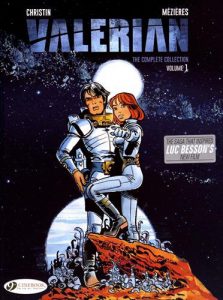Looking for a “Valerian” fix after last year’s movie, “Valerian and the City of a Thousand Planets,” I’m delving into the comics that started it all, by Frenchmen Pierre Christin (writer) and Jean-Claude Mezieres (pencils and inks). “The Complete Collection, Volume 1” includes “Bad Dreams” (1967), “The City of Shifting Waters”/“Earth in Flames” (1970) and “The Empire of a Thousand Planets” (1971).
Tailored to people like me who are just getting into “Valerian” after seeing the movie, Cinebook’s 2016 English-translated collection includes a nice introductory section featuring an interview with the film’s writer-director Luc Besson and the two comic creators, along with bios of the creators and an overview of aspects of “Valerian” that influenced later sci-fi franchises. Side-by-side photos on page 17 show how “Star Wars’ ” Millennium Falcon, slave Leia, carbon-freezing slab, Darth Vader and Watto borrowed from Mezieres’ work. Especially handy is a section that outlines the historical context of the three stories in this volume. One quibble with the book’s production: The spine is printed upside-down.
Volume 0: “Bad Dreams” (1967)
Translated and collected for the first time here, Valerian and Laureline’s debut adventure has more historical value than entertainment value. Christin and Mezieres’ imaginations explode off the page as they establish Galaxity, the capital of Earth in 2720, where spatio-temporal agent Valerian launches his missions from. His nemesis is Xombul, who goes to 11th century France to carve out a chunk of space-time to rule over. The whole thing is light, breezy and funny, as the creators’ storytelling, characterizations, themes and art haven’t caught up to their imaginations (for example, a bog with bubbles filled with sleeping gas).
The highlight is the bringing together of Valerian and Laureline, a French peasant. In the fashion of old fables, she rescues Valerian from a leaf-trap in the woods and immediately becomes his unquestioning helper. The formula of the duo rescuing each other is here from the start; it’s a cute and lovable aspect of the saga, and it also shows that Laureline is a precursor to Princess Leia and other sci-fi heroines. While she is sometimes in distress – as anyone would be in these crazy adventures — she’s not a helpless, terrified damsel.
However, she is also clearly the second fiddle to Valerian at this point, owing perhaps to the male perspective of the creators. There’s a cute anecdote in the Blu-ray bonus features where Christin and Mezieres are shy about meeting Cara Delevingne, Laureline brought to life. There’s a sense that they love Laureline, but she’s a woman, so they don’t totally understand her in “Bad Dreams.” She’s more like a magical creature, and indeed, she turns into a unicorn for one stretch.
One might think Laureline’s transition from peasant to spatio-temporal agent would be worthy of a story itself, but it actually happens in one panel, as she uses the “mnemonic machine” on Valerian’s space-time ship to “teach you everything you need to know” (page 47). A similar device would be seen in Besson’s “The Fifth Element” (1997), as Leeloo absorbs the English language and Earth history.
2.5 stars
Volume 1: “The City of Shifting Waters”/“Earth in Flames” (1970)
I enjoy the fact that Valerian and Laureline are such amiable partners right off the bat, but these adventures could probably use a touch more of the banter found on page 68, where Christin acknowledges but undercuts the established structure of the male lead and the female underling (even though, yes, Valerian is the higher-ranking officer):
Valerian: “The cheek of these spatio-temporal agent chicks!!! You know, I always thought the service should be exclusively for us men – you’re all too smart for us … What are you working on now, anyway?”
Laureline: “Ha ha! You’ll see why we get accepted into your prestigious organization … It’s because we can cook! And how! See how elegantly these tins were opened, hmmm? … Dinner is served!”
The real joys of this second “Valerian” story are the location and the world-building: The agents travel to 1986 New York City, which I am compelled to point out is also where time-traveler Renet travels to in Eastman & Laird’s “Teenage Mutant Ninja Turtles” Issue 8, where she of course encounters talking mutant turtles. While that yarn was written in 1986, “Shifting Waters” is looking into the future from 1970.
Meanwhile, Valerian is discovering this era from the perspective of the 28th century. We learn that all recordings of Earth history from 1986 through the 24th century have been lost. As such, travel to that period is forbidden, but the agency makes an exception in order to catch Xombul.
This story is a climate change parable (and a Cold War parable, as an accidentally detonated hydrogen bomb triggers the ice caps to break off). I’m again compelled to bring up the grim future of E&L’s “TMNT,” where NYC has been swamped (2010’s “Tales of the TMNT” Issue 69 particularly comes to mind). It’s the same thing here, and the real pleasure is Mezieres’ vibrant art that shows us what life is like traveling around by boat in the ruins of a once-great city. In an evocative sequence, our heroes follow a series of green stoplights underwater as a path to Xombul’s base.
The sequel, “Earth in Flames,” takes us to the Rocky Mountains. We get a flavor for the desperate conditions among survivors, who are running out of supplies. There’s a definite “Walking Dead” vibe. While this is an example of how Christin is cognizant of the wider context of the world our heroes are adventuring in, the focus ultimately returns to the final battle against Xombul. Among the fun inventions are prison bubbles that actually serve as V&L’s salvation as they travel through lava; they are reminiscent of the plastic bubbles used for “safe” dinosaur viewing in “Jurassic World.”
V&L’s ally in this story, Sun Rae, is also worth mentioning as an example of how Christin incorporates supporting players. Much like how Laureline joins Valerian in “Bad Dreams,” he hops along for the ride; there’s never any period where characters feel each other out to see if they can be trusted. That adds an innocent vibe to the proceedings. But at the same time, every character has self-interest, and isn’t necessarily altruistic; Sun Rae ultimately wants to stay and lead rebuilding efforts in this time and place, largely because he craves the position of power.
3 stars
Volume 2: “The Empire of a Thousand Planets” (1972)
Everything clicks into place here, in what the introduction accurately calls the first “great” “Valerian.” Despite the title, it has nothing to do with the similarly named movie. Rather, V&L travel to Syrte, a planet where the citizenry is ruled by Enlighteneds, mask-wearing figures whose design has been compared to Darth Vader (although I personally think they look much more like the Imperial Sentinels drawn by Cam Kennedy for 1991’s “Star Wars: Dark Empire”).
In a lesser story, the mystery of why Syrte’s leaders seem to know our heroes are from Earth (even though this is supposedly the first contact between the planets) would be brushed off as “Oh, it’s just a sci-fi comic; go with it.” But here, it’s integral to the plot. Though “Valerian” is sometimes labeled “kids’ stories” (maybe because all comics were seen that way back in the day), I don’t get that vibe from “Thousand Planets” like I did at times on the first two yarns.
The formula is in place as Valerian aims to rescue Laureline from the ruler’s castle, but she ends up rescuing him; and Mezieres lets his imagination run wild on the duo’s side trips. The parallels to other franchises abound. Egyptian-style temples in the woods call to mind the Massassi temples on Yavin in “Star Wars: A New Hope,” and ice caverns look like the Fortress of Solitude in 1978’s “Superman” (granted, the “Superman” comics might’ve gotten there first).
Valerian is confined to an amber truth-telling slab that had to have been a visual inspiration for the carbonite slab in “The Empire Strikes Back,” Black Street calls to mind the slums of Coruscant from “Dark Empire” and other “Star Wars” comics and books, and the reveal of the Enlighteneds’ true visages parallel the revelation of Vader’s hideously scarred human face in “Return of the Jedi” and “Revenge of the Sith.” The conclusive space battle is like “Return of the Jedi’s” Battle of Endor, except with a time-travel element as well, as Valerian hops his ship to various points of the skirmish to land key blows.
The formula of our heroes traveling to a world and helping to liberate it would be used in many issues of the original Marvel “Star Wars” comics (1977-85), but many of those stories promoted the notion of benevolent kings. Christin has a less Pollyanna view on that count, and of human nature in general: Valerian, Laureline and their merchant ally Elmir spark the revolution, but it only leads to different rulers, not to true liberty. However, the pragmatic Elmir is OK with that, as he sees an angle he can exploit (page 158): “I don’t really mind, to be honest. Whatever regime replaces our dynasty of halfwits, they’ll have need of clever people.”
4 stars
Click here for a complete index of “Valerian and Laureline” reviews.


